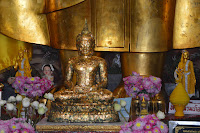Okay, this trip was well worth suffering through Captain's attempts to say the name correctly. Commonly known as Wat Pho, or the Temple of the Reclining Buddha, this site has a much more complicated name: Wat Phra Chetuphon Wimon Mangkhalaram Rajwaramahawihan.
It's not like you did an acceptable pronunciation, either, Spike! I seem to recall some rather tortured growls coming from you!
True. Now, there are several important things to know about Wat Pho. Wat Pho was built before Bangkok was the capital of Thailand, and it's named after the monastery in India where Buddha received enlightenment.Now, as if that wasn't enough to make this temple special, the history of the temple links back quite a ways. In 1767, it was elevated to royal monastery. Then, King Rama I began rebuilding and renovating the site. While this was happening, Buddha images from many temples were moved here.
The entire temple site covers more than 80,000 square meters!
It has over 1,000 Buddha images, too. Be respectful. You cannot climb on or sit on a Buddha image. This can get you in serious trouble! (That selfie isn't worth it!)
The largest, and incredibly breathtaking Buddha is the Reclining Buddha. This statue is huge! Imagine 49 feet tall and just over 150 feet in length!
It's so large that we had to take pictures in sections, as you can see. Now, if you think of a person 150 feet tall, you can imagine everything about that person would be enormous. The feet are actually really cool.
The bottom of the feet have inlaid mother of pearl and are almost 10 feet tall.
The pillows used to rest Buddha's head are also quite impressive. We're glad not to need to change those pillowcases.
Now that you've seen the Reclining Buddha, you might think, "What else is there to see?" Just remember 80,000 square meters...This impressive image is not the only thing in Wat Pho.
Look around the Buddha before leaving Phra Vihara (the assembly hall where Phra Buddhasaiyas lies). Besides all the murals which tell legends and historical stories, there is a huge framed stone. The stone is blank, but it is believed to have been made to tell the history of the building.
There are actually 16 entrance gates. Some of them are more ornate than others, and a few are guarded.
Keep walking around, and you will see the Phra Prang at each corner. These represent compass points and are quite ornately decorated. They are dedicated to the god of the winds.
Around the back of the complex, you will be getting tired! I know we were, but it's worth it when you see the architecture and all of these:
There is a pavilion used by the monks every day. Do not sit in the chairs! Also, before you go, remember this is an active site of worship. You will need to dress appropriately and remove your shoes before entering any of the buildings.
Spike and I have learned to wear easy slip-on shoes and socks when we visit temples. If you bring a bag, slip your shoes inside in case you leave by a different doorway!
Speaking of doorways, you need to step OVER, not on the thresholds. These are raised, so pay attention or you might trip! The thresholds are raised to keep out evil spirits and as the home of the guardian spirit. It's bad luck to step on it!
Oh, and if you visit during the rainy season, be sure to bring an umbrella and some dry socks for walking into the temples!





































No comments:
Post a Comment